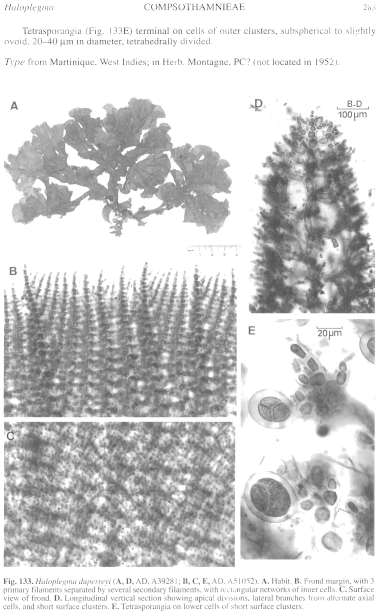|
|
|
|
|
|||||||||||
|
Electronic Flora of South Australia Species Fact Sheet
Phylum Rhodophyta – Order Ceramiales – Family Ceramiaceae – Tribe Compsothamnieae
Selected citations: J. Agardh 1851: 111; 1876: 90. Børgesen 1931: 14, fig. 9; 1952: 52, fig. 26. Cribb 1983: 42, pl. 28 figs 1–3. De Toni 1903: 1365. Kützing 1849: 672; 1862: 19, pl. 62a–c. Millar & Kraft 1993: 41. Taylor 1950: 137; 1960: 513. Silva et al. 1996: 414.
Thallus (Fig. 133A) red-brown to grey-red, flat and complanately branched, 1–10 cm high, flabellate to lobed, becoming divided or lacerate, lobes expanding upwards to (1–) 2–4 cm broad, mostly 400–600 µm thick, margins smooth to slightly ruffled. Stipe 2–5 mm long, 1–2 mm in diameter, holdfast 2–8 mm across, rhizoidal; epilithic or on shells (one specimen on old axes of Doxodasya bulbochaete). Structure. Marginal apices (Fig. 133B) regularly fringing the blades, with primary apices and filaments separated by numerous secondary apices from lateral filaments. Apices with alternate laterals (Fig. 133D) from 3–6 cells below the apical cells, walls more or less transverse, apical cells 10–18 µm in diameter and L/D 1–1.5. Laterals of apical filaments uniting with next adjacent filaments to form a rectangular network (Fig. 133B), with other irregular filaments, the outer cells developing short branch clusters (Fig. 133C, D). Cells of internal filaments 25–45 µm in diameter and L/D 3–7, outer clusters 45–100 µm long with ovoid basal cells 15–30 µm in diameter, branched 1–3 times with terminal unbranched rows of 2–4 cells, 8–14 µm in diameter, isodiametric to slightly ovoid. Cells multinucleate; rhodoplasts discoid to elongate, ribbon like in larger cells.
Reproduction: Gametophytes not observed.
Tetrasporangia (Fig. 133E) terminal on cells of outer clusters, subspherical to slightly ovoid, 20–40 µm in diameter, tetrahedrally divided.
Type from Martinique, West Indies; in Herb. Montagne, PC? (not located in 1952).
Selected specimens: Elliston, S. Aust., 11 m deep in bay (Shepherd, 27.x.1971; AD, A42683). Point Lowly, Upper Spencer Gulf, S. Aust., 22–24 m deep (Shepherd, 22.vii.1971; AD, A39281). N Spencer Gulf, S. Aust., 18 m deep (Shepherd, 13.ix.1973; AD, A44290). Redcliff Point, N Spencer Gulf, S. Aust., 13–14 m deep (Shepherd, 9.iv.1980; AD, A51052). Vivonne Bay, Kangaroo I., S. Aust., in completely shaded pool, S side of Ellen Point (Womersley, 22.xi.1968; AD, A32886). Robe, S. Aust., in shaded pool (Womersley, 27.viii.1949; AD, A11072). Nora Creina, S. Aust., in shaded cavern, uppermost sublittoral (Womersley, 19.xii.1971; AD, A41163).
Distribution: West Indies, tropical and subtropical Indian Ocean, Japan, NW Aust., Qld, and Lord Howe I.
In southern Australia, known from Elliston, N Spencer Gulf, Kangaroo I., and Robe and Nora Creina, S. Aust.
Taxonomic notes: Specimens from Elliston and N Spencer Gulf are well developed and 8–15 cm high, occurring in moderately deep water with considerable current flow, whereas those from rough-water coasts (Vivonne Bay, Robe and Nora Creina) occur in heavily shaded pools or caverns and are often only 1–2 cm high. Few of these specimens are fertile but they appear to agree well vegetatively with H. duperreyi; tetrasporangia have been observed in AD, A51052.
Details of the female reproduction have apparently never been described, though Taylor (1950, p. 513) records carposporophytes for the genus.
References:
AGARDH, J.G. (1851). Species Genera et Ordines Algarum. Vol. 2, Part 1, I-XII, 1–336 + index. (Gleerup: Lund.)
AGARDH, J.G. (1876). Species Genera et Ordines Algarum. Vol. 3, Part 1- Epicrisis systematic Floridearum, pp. i-vii, 1–724. (Weigel: Leipzig.)
BØRGESEN, F. (1931). Some Indian Rhodophyceae especially from the shores of the Presidency of Bombay. Bull. Misc. Inf., Roy. Bot. Gard., Kew, No. 1, 1–24, Plates I, II.
BØRGESEN, F. (1952). Some marine algae from Mauritius. Additions to the parts previously published. IV. K. Dan. Vidensk. Selsk. Biol. Meddr 18(19), 1–72, Plates 1–5.
CRIBB, A.B. (1983). Marine algae of the southern Great Barrier Reef-Part 1. Rhodophyta. Aust. Coral Reef Soc.Handbook No. 2.
DE TONI, G.B. (1903). Sylloge Algarum omnium hucusque Cognitarum. Vol. 4. Florideae. Sect. 3, pp. 775–1521 + 1523–1525. (Padua.)
KÜTZING, F.T. (1849). Species Algarum. (Leipzig.)
KÜTZING, F.T. (1862). Tabulae Phycologicae. Vol 12. (Nordhausen.)
MILLAR, A.J.K. & KRAFT, G.T. (1993). Catalogue of marine and freshwater Red Algae (Rhodophyta) of New South Wales, including Lord Howe Island, South-western Pacific. Aust. Syst. Bot. 6, 1–90.
MONTAGNE, C. (1842) Troisieme centurie de plantes cellulaires exotiques nouvelles. Decades V, VI, VII, et VIII. Ann. Sci. Nat. Bot. Ser. 2, 18, 241–282, Plate 7.
SILVA, P.C., BASSON, P.W. & MOE, R.L. (1996). Catalogue of the Benthic Marine Algae of the Indian Ocean. (University of California Press: Berkeley, Los Angeles & London.)
TAYLOR, W.R. (1950). Plants of Bikini and other Northern Marshall Islands. (Univ. Mich. Press: Ann Arbor.)
TAYLOR, W.R. (1960). Marine Algae of the eastern tropical and subtropical coasts of the Americas. (Univ. Mich. Press: Ann Arbor.)
The Marine Benthic Flora of Southern Australia Part IIIC complete list of references.
Publication:
Womersley, H.B.S. (24 December, 1998)
The Marine Benthic Flora of Southern Australia
Rhodophyta. Part IIIC. Ceramiales – Ceramiaceae, Dasyaceae
©State Herbarium of South Australia, Government of South Australia
Illustration in Womersley Part IIIA, 1998: FIG. 133.

Figure 133 enlarge
Fig. 133. Haloplegma duperreyi (A, D, AD, A39281; B, C, E, AD, A51052). A. Habit. B. Frond margin, with 3 primary filaments separated by several secondary filaments, with rectangular networks of inner cells. C. Surface view of frond. D. Longitudinal vertical section showing apical divisions, lateral branches from alternate axial cells, and short surface clusters. E. Tetrasporangia on lower cells of short surface clusters.

|
Email Contact: State Herbarium of South Australia |

|